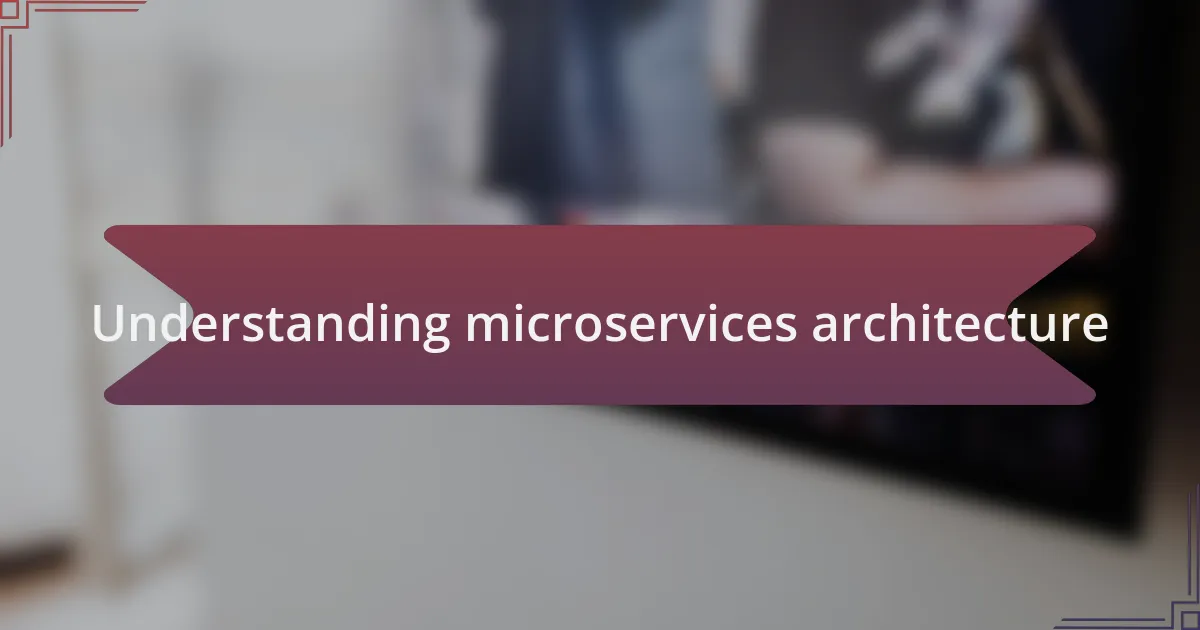Key takeaways:
- Microservices architecture allows independent scaling, enhancing fault tolerance and deployment speed, resulting in improved user experiences.
- Effective monitoring, clear service boundaries, and automated deployment/testing are critical best practices for managing microservices.
- Collaboration and thorough documentation are vital for sustaining knowledge sharing and adapting to changes in team dynamics.
- Future trends indicate a shift towards increased automation, service mesh technology for improved communication, and advanced observability tools for better user insights.

Understanding microservices architecture
Microservices architecture is a design approach focused on breaking down applications into smaller, independent services that can be developed, deployed, and scaled individually. When I first started working with microservices, I was amazed by the flexibility it offered. It truly feels liberating to know that if one service fails, it doesn’t necessarily mean the entire system crumbles.
One of the most compelling aspects of microservices is how it fosters a culture of innovation. Each team can experiment with different technologies without impacting others. I remember a project where one team implemented a new database solution that dramatically improved performance, while other teams continued using their trusted systems. It opened my eyes to the potential of diverse technology stacks and how they can coexist.
However, managing so many moving parts can feel overwhelming at times. How do you ensure that all these services communicate effectively? From my experience, implementing clear APIs and using orchestration tools can provide the framework needed to maintain order. While I’ve faced challenges, I’ve also seen firsthand how this architecture can lead to significant improvements in deployment frequency and reliability when done right.

Benefits of using microservices
One of the primary benefits of using microservices is the ability to scale services independently. I remember a particular project where our user base surged unexpectedly. Thanks to microservices, we could quickly scale our user authentication service without having to touch the entire application. It was such a relief to see that we could respond to demand efficiently, ensuring a smooth experience for our customers.
Another big win with microservices is the speed of deployment. When I transitioned to this architecture, I found myself deploying small updates multiple times a day instead of the lengthy release cycles we used to have. It gave our team a sense of agility that I hadn’t experienced before; pushing out new features felt exhilarating. Does anyone else share this thrill of instant updates? It really transforms how we think about improvements and innovations.
Moreover, microservices enhance fault tolerance. I recall a time when a specific service encountered a bug. Instead of the entire application going down, we isolated the issue, allowing other services to continue functioning. This not only minimized downtime but also gave our team confidence in managing errors. Each challenge became a learning opportunity, ensuring we were more prepared for the next hurdle.

Best practices in microservices management
Implementing effective monitoring and logging is crucial in microservices management. In my experience, setting up a centralized logging system was a game-changer. I recall a challenging period when our microservices architecture led to scattered logs, making troubleshooting a nightmare. By using tools like ELK Stack, which stands for Elasticsearch, Logstash, and Kibana, we consolidated our logs, allowing us to track issues in real time. How many times have you found yourself searching blindly for answers in a sea of data?
Another best practice I’ve adopted is establishing clear service boundaries. Early on, I learned the hard way that vague separations between services can lead to tangled dependencies. For instance, I once had a microservice that was supposed to handle only user profiles but ended up taking on additional roles like analytics processing. This complicated our architecture and slowed down both deployment and debugging. Clearly defining what each service does enhances maintainability and makes life easier down the road.
Finally, embracing automation for deployment and testing cannot be overstated. I often reflect on the manual processes we used to rely on before adopting Continuous Integration and Continuous Deployment (CI/CD) pipelines. The transition felt daunting initially, with all the new tools to learn, but the payoff was incredible. Automated testing and deployment allowed us to catch bugs earlier in the lifecycle, reducing stress significantly. How could anyone argue against having the peace of mind that comes with knowing your code is validated every step of the way?

Tools for managing microservices
Tools for managing microservices are essential to streamline operations and ensure reliability. I’ve had great success with container orchestration tools like Kubernetes. I remember a time when we were struggling to scale our application, and Kubernetes stepped in like a hero, managing our containers automatically and balancing loads without breaking a sweat. It made me wonder—how did we ever function without such sophisticated orchestration?
Another invaluable tool that I’ve integrated into my workflow is Istio. This service mesh solution allows for seamless communication between microservices, adding a layer of security and traffic management. I recall a project where we faced significant latency issues while services communicated. After implementing Istio, we were able to monitor and control the service interactions effectively, drastically improving our response time. Isn’t it fascinating how the right tool can turn a frustrating challenge into a straightforward process?
For error tracking and performance monitoring, I can’t recommend Sentry enough. In my experience, it has transformed the way I approach issues in real-time. I vividly remember receiving instant alerts during a critical launch, which allowed my team to address problems before they became full-blown disasters. Have you ever experienced that immediate relief when a tool highlights issues before they escalate? Sentry provided just the right amount of insight, and I stood there thinking how much simpler our lives became with such effective monitoring at our fingertips.

My approach to microservices
When I first embraced microservices, I focused on establishing a clear communication strategy between the services. I found that using asynchronous messaging with tools like RabbitMQ truly enhanced our system’s reliability. It reminded me of a time when one service failed, risking the entire application, but implementing message queues saved our progress and kept everything running smoothly. Does that kind of assurance not make you feel more confident in your architecture?
The next step in my approach was to embrace agile development practices. Each iteration felt like a fresh start, allowing me to refine services based on actual user feedback. I can vividly recall a release where we misjudged user needs; rather than panic, we quickly adapted through iterative cycles, evolving the service based on what our users truly wanted. Isn’t it empowering to pivot quickly when you have the right processes in place?
Testing is another cornerstone of my microservices approach. I dedicated significant time to building robust automated tests across all endpoints. One memorable release night, as I watched our deployment dashboard, I felt an incredible sense of relief knowing that our automated tests had caught potential failures before they could impact users. Have you ever felt that wave of comfort when you realize you’ve prepared your software to face the unexpected challenges?

Lessons learned from my experience
One of the most valuable lessons I’ve learned is the importance of documentation. Early on, I would often skip this step in favor of coding. However, I recall a stressful situation when a new team member struggled to understand our service architecture. That experience taught me that detailed documentation not only helps onboard new developers but also preserves knowledge when team dynamics change. How often do we realize too late that clarity can prevent chaos?
Another lesson came from the reality of service failure. Initially, I underestimated the need for robust monitoring and alerting systems. I remember a particularly anxious night when a critical service went down, and we scrambled to diagnose the problem. Since then, I’ve prioritized having observability tools in place. This not only provides peace of mind but also allows us to respond swiftly to issues before they escalate. Doesn’t having such safety nets make the entire process feel more secure?
Lastly, fostering a culture of collaboration has been key in my experience. I used to think I could handle the architecture and implementation alone. But after a challenging project where communication broke down, I learned the hard way that involving the team from the ground up breeds innovation. Creating an open dialogue for feedback and brainstorming fosters a sense of ownership and leads to better outcomes. Have you ever felt that collective energy when everyone contributes to a common goal?

Future trends in microservices management
The future of microservices management is undeniably moving towards increased automation. I remember implementing a CI/CD pipeline early in my career, which drastically reduced deployment times. Today, I see trends leaning towards using AI and machine learning to automate processes like scaling services based on demand. Isn’t it fascinating to think about how much easier our lives could be if these intelligent systems were handling routine tasks for us?
Another significant trend is the rise of service mesh technology, which enhances communication between microservices. My first foray into service mesh was quite the eye-opener. Suddenly, I had more control over traffic management and could enforce security policies without rewriting my services. I can’t help but wonder, will service meshes become the standard for all microservices architectures?
Lastly, observability is evolving to a new level, focusing on not just knowing what’s wrong but understanding why. In one project, I learned firsthand that simply knowing when a service is down isn’t enough. Now, with the advent of advanced tracing tools and logs that provide insights into user behavior, the management of microservices will not only improve our debugging capabilities but also enhance user experience drastically. How often do we overlook the user journey when we are deep in the technical weeds?